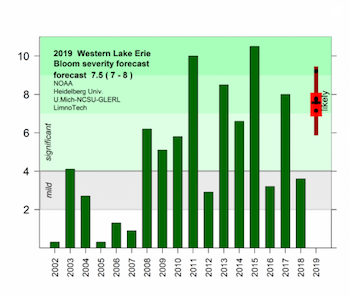 As residents of Northwest Ohio, you have all likely hear quite a lot about the harmful algal blooms that can occur in portions of Lake Erie’s Western Basin. Algae is a normal and necessary component of the Lake’s aquatic food web, and growth of this microscopic plant naturally increases in the warmer summer months. The problem for our end of the Lake is that human impacts are enhancing the growth of certain strains of algae beyond what is ecologically normal. These impacts include nutrient (i.e., fertilizer) runoff into the Lake and habitat alternation (e.g., removal of natural wetlands). The strain of algae that has residents and scientists concerned is the blue-green algae.
As residents of Northwest Ohio, you have all likely hear quite a lot about the harmful algal blooms that can occur in portions of Lake Erie’s Western Basin. Algae is a normal and necessary component of the Lake’s aquatic food web, and growth of this microscopic plant naturally increases in the warmer summer months. The problem for our end of the Lake is that human impacts are enhancing the growth of certain strains of algae beyond what is ecologically normal. These impacts include nutrient (i.e., fertilizer) runoff into the Lake and habitat alternation (e.g., removal of natural wetlands). The strain of algae that has residents and scientists concerned is the blue-green algae.
Fortunately, this issue is not lost on scientists working at local, regional, and national levels. NOAA and several of its partners recently released an article discussing the implications of harmful algal blooms and the tools that scientists are using to study them. The article describes the blooms as consisting of “cyanobacteria, also called blue-green algae, that are capable of producing the liver toxin microcystin that poses a risk to human and wildlife health (Ohio Seagrant, 2019).” Click here to access the article directly.
These scientists are using a suite of advanced forecasting/modeling tools to better understand the blooms and to help keep communities that use the Lake and its resources safe during the blooms. These tools predict that on a severity index of 0-10, this year’s bloom is expected to come in at an index of 7.5; a severity higher than 2018, but slightly less than 2017. Scientist also know that bloom size is not related to its possible toxicity and blooms are not always toxic. The general rule of thumb, regardless of the published severity index, is to avoid contact with Lake water if you notice a green “scum” on the surface. Unfortunately, this summer the bloom in western Lake Erie has affected the public beach at Maumee Bay State Park.
Although this is a large-scale problem that needs to be addressed by large-scale actions, individuals can certainly play a part in the solution. Some example of citizen-level contributions include reducing runoff from our own lawns with rain barrels and/or native, deep rooted plants, keeping pollutants out of storm drains (including pet waste and fertilizers), and supporting initiatives that focus on habitat restoration within the Lake Erie Watershed. A little effort by individuals can go a long way when done collectively!
